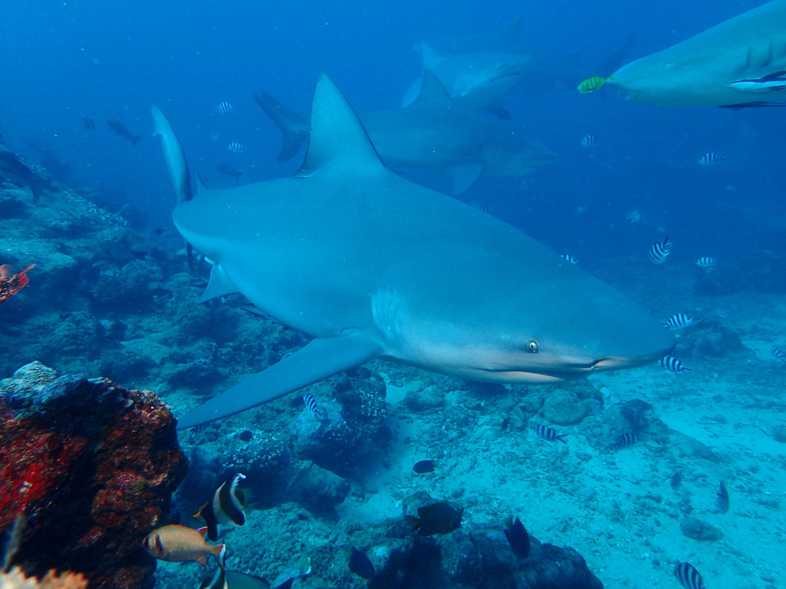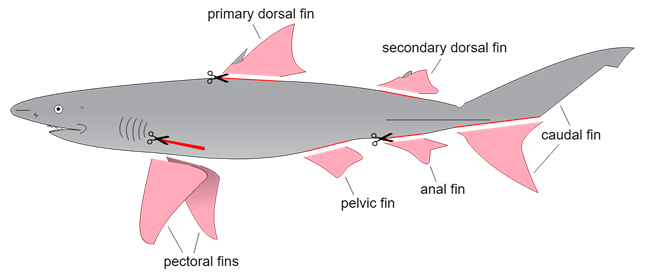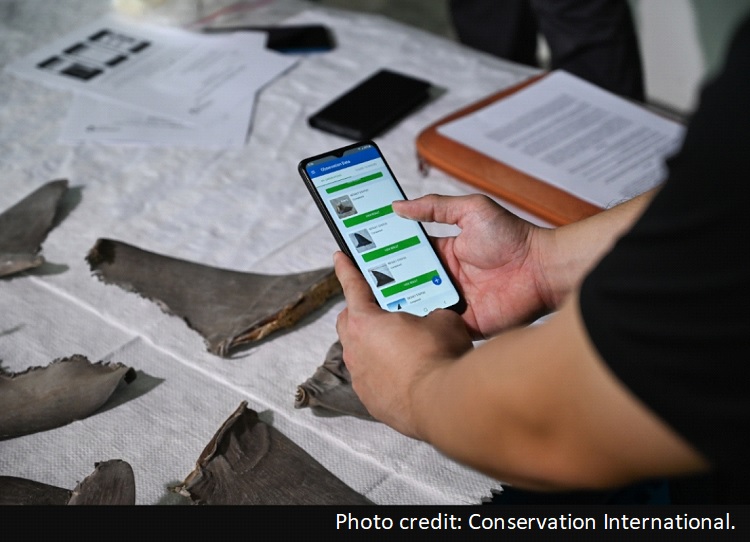
Photo by: Jeffrey Low
Sharks and rays are a type of cartilaginous fish belonging to the subclass Elasmobranchii. They are characterised by their skeleton being made of cartilage rather than bone. In addition, they also possess five to seven gill openings on each side of their body and rigid dorsal fins. They have several rows of teeth that can continually replace worn-out ones.
There are over 1,000 species of sharks and rays, found across freshwater and saltwater habitats. Of over 1,000 species of sharks listed in the IUCN Red List of Threatened Species, 25% of them are classified under the threatened categories (Critically Endangered, Endangered or Vulnerable) and around 45% of shark and ray species are classified under Data Deficient. Only less than 25% of shark and ray species are listed under the category of Least Concern.
Some species commonly involved in the sharks and rays trade include:
- Oceanic whitetip shark (Carcharhinus longimanus) – Critically Endangered
- Great hammerhead (Sphyrna mokarran) – Critically Endangered
- Shortfin mako shark (Isurus oxyrinchus) – Endangered
- Giant guitarfish (Rhynchobatus djiddensis) – Critically Endangered
- Giant devilray (Mobula mobular) – Endangered
One of the main threats faced by sharks and rays is overfishing. Sharks are most often fished for their fins, which are considered a delicacy in some Asian countries. Rays are fished for their gill rakers, which are used in traditional medicine. Populations of sharks and rays are declining around the world as they face the immense pressure from overfishing where they are fished at rates that exceed their capacity to replenish. Amongst the shark species alone, it is estimated that around 100 million sharks are killed each year, with the majority of them killed to meet the demands of the shark fin trade. Often the shark’s fins are cut off and the rest of the fish discarded back into the ocean, where they will slowly die from lack of oxygen and loss of blood.
Trade regulations for sharks, rays and shark fins
Throughout the years, there has been a growing recognition for the protection of sharks and rays under the Convention on International Trade in Endangered Species of Wild Fauna and Flora (CITES). During the 18th Conference of the Parties (CoP18) to CITES held in 2019, 18 more species of sharks and rays, which included mako sharks, guitarfishes & wedgefishes ,were added to Appendix II of CITES.
Singapore has been a Party to CITES since November 1986. As such, it is illegal to import and export any CITES-listed shark and ray species under the Endangered Species (Import and Export) Act (Cap. 92A). Under this Act, it is an offence to possess, sell, offer for sale, or publicly display any CITES species, as well as their parts and derivatives without the necessary CITES permits.
Other national legislations in place include the Fisheries Act which regulates the marketing and distribution of fish and the Wholesome Meat and Fish Act which regulates the import, export and tranship of any fish products without a license and permit.
Identification of shark fins

Image source: https://commons.wikimedia.org/wiki/File:Shark_finning_diagram.svg
Identification of the dried and wet fins of sharks and rays using morphological characteristics can be particularly useful for law enforcement personnel. The most commonly traded fin types in the shark fin trade include: the first dorsal fin, pectoral fins, and the lower lobe of the caudal fin. Other fins such as the upper caudal lobe, second dorsal fin, pelvic fins, and anal fins are less valuable but may also be traded. Factors such as the type, size, colour and markings can help identify whether fins sold belong to a CITES-listed species. Please refer to the following for a comprehensive field guide on identifying shark fins and wedgefish/giant guitarfish fins using morphological characteristics
Artificial intelligence (AI) is employed to visually identify shark and ray species. As part of NParks' Centre for Wildlife Forensics' work, NParks, Microsoft and Conservation International collaborated to create an AI-powered mobile application known as Fin Finder to support inspectors in the rapid identification of sharks and rays species. Learn more about Fin Finder.

DNA-testing can also be employed to assist in the identification of CITES-listed species in cases where fins are processed, making it difficult to identify the species based on morphological characteristics. In addition, new techniques and tools such as multiplex real-time PCR assay or loop-mediated isothermal amplification assay are also being developed to be able to identify whether fin samples belong to CITES-listed species under a short timespan of several hours.
How can you help?
In order to play your part to help reduce demand for shark fin, opt for more sustainable alternatives such as imitation shark fin soup made from other ingredients or opt for other dishes altogether. If you must consume sharks and rays, always check the source of origin and species being harvested to ensure that they are not a CITES-listed species before consumption.
If you spot any occurrences of illegal wildlife trade, and ownership of endangered or wild species and its parts, you may contact NParks using the online feedback form or call 1800-476-1600. All information shared with NParks will be kept confidential.